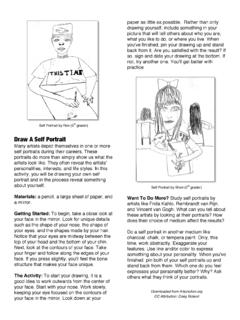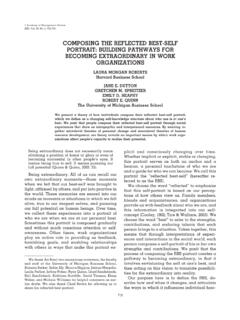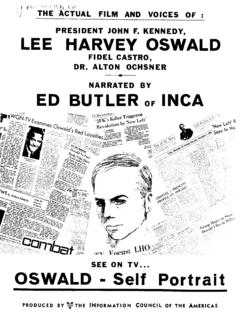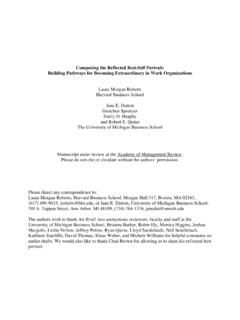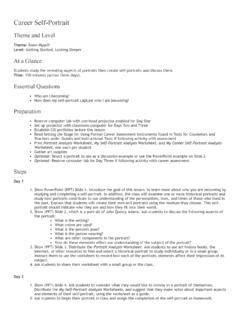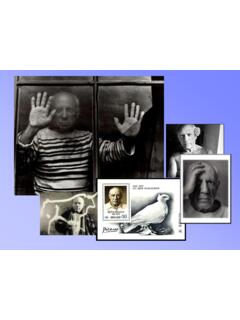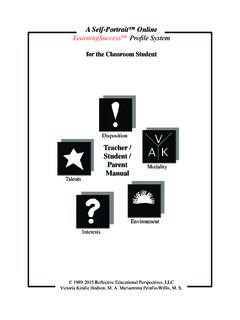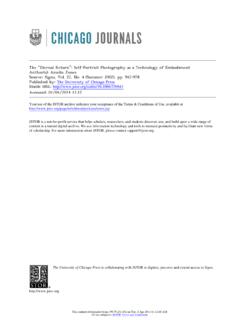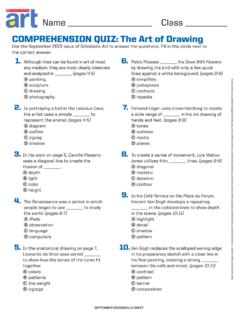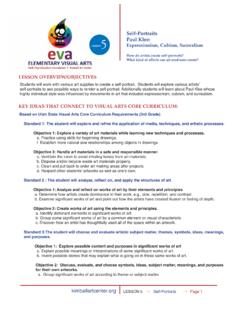Transcription of Creating Self-Portraits - Life-Role Development Group
1 Creating self -PortraitsDave E. Redekopp, Barrie Day & Kris MagnussonBackground Creating Self-Portraits (Redekopp, Day, Magnusson & Durnford,1993) is an individual and/or Group career Development tool designedto assess without testing. As we began to increasingly adopt adevelopmental approach ( , Gelatt, 1989; Magnusson, 1990; Super,1985) to career assistance, it became apparent that the use of tests (ofvirtually any variety) was counter-productive. Rather than helpingclients to "know themselves," tests were abdicating clients from theirself-examination responsibilities. Tests provided clients with labels( , ENTJ, RIA, learning disabled, blue, analytic) that encouragedthem to foreclose on their self -exploration processes (much as weprodded them to do otherwise). Once labelled, clients felt no need tofurther self -analyze. This foreclosure was particularly troublesomebecause these labels were not all-inclusive; they encapsulated only onecomponent ( , interests, aptitudes) of the person's being.
2 Obtaininga classification of one part of themselves, such as interests, clients hada tendency to stop exploring other aspects, such as values. The self -discovery barrier erected by the wall of test results was notour only difficulty with tests. We found that a large number of testsalso prevented an open exploration of the world of work. Clients werelooking to tests to discover "what they should be," and they displayeda strong tendency to believe the subsequent test results. We, ofcourse, did our best to dissuade them of these rigid beliefs by pointingout that tests can only provide a sample of possible occupations andthat further exploration was necessary, but after some time we beganto wonder why we were using methods that we immediately had todisqualify. We felt akin to someone giving travel directions to atourist and then spending twice the time telling the tourist how thedirections would not likely get them to their destination.
3 The above problems would have not been so troublesome if only ourclients and the labour market stood still. They did not remainmotionless, however. New occupational roles were (and still are)emerging almost daily and existing roles were (and still are) changingdaily. Our clients, too, were changing before our eyes. We saw"technophobes" learn to love computers as they acquired the necessaryskills; employees blossom into entrepreneurs; and academics becomeavid marketers when exposed to the appropriate mentors. The labormarket was becoming a "work dynamic" (Redekopp, Fiske, Lemon &Garber-Conrad, 1994) in which our clients were able to activelyparticipate when provided with meaningful developmental experiences. We found that the tests that matched traits with occupations wereinadvertently arresting the Development of our clients with regards toseeing their own Development and the changing nature of work. We originally resolved some of these problems in the same wayother career Development practitioners have been doing for years: bytaking a considerable amount of time to explain to clients the theoriesbehind the specific tests, the difficulties of test construction, thespecific meanings of test terminology, and the limitations of testresults.
4 In other words, we made our clients thoroughly understandour discipline. Then we began to feel like automotive technicians whowill not repair cars until their customers understand the intricacies offuel injection. The above is obviously a slightly fictional characterization of ourthinking and practice, but it serves the purpose of demonstrating ourmotivation for developing Creating Self-Portraits . We wanted a toolthat would assist people to understand themselves: "in a way that would encourage further self -exploration; "in a detailed and broad manner ( , including many parts ofthe self , each part being examined comprehensively); "in a way in which this understanding can change over time; "without labels, classifications or taxonomies; "using their own terminology rather than our terminology;and "in a way that did not link the individual's self -explorationwith an occupational role or set of occupational roles ( ,divergence promoting rather than convergence promoting).
5 Description Creating Self-Portraits is a simple method that assists clients toexamine themselves from four aspects: "meaning ( , values, beliefs, interests and barriers tomeaning), "outcomes ( , the components of a dream or future vision), "activities (including preferred, past and needed), and "tools/techniques (including skills, knowledge, personalcharacteristics and attitudes). This information is laid out in four columns on a large (17" x 22")sheet of paper. A partially completed self - portrait is shown below(the italicized portions represent part of one of the author's currentSelf- portrait ; the full self - portrait is considerably longer). The "values" portion of the "meaning" column is intended to captureitems that are fundamentally important to the client. These are neitherright nor wrong; they are simply important. Values are the client'senduring motivators. The "beliefs" component attempts to identifyelements of the client's worldview.
6 These include opinions about self ( , "I'm not very smart"), conduct ( , "A stitch in time savesnine") and the world ( , "There are no jobs"). Beliefs guide theclient's approach to fulfilling values. Some may needed to be changedif the client is to move towards his or her outcomes. The "interests"section captures events that the person enjoys. They need not bevaluable ( , one can value children without being interested inworking with children) or in conformity with belief systems: they arejust fun and enjoyable. "Barriers" are conditions that prevent meaningfrom being fulfilled. These are often the "yes, buts" of counsellingsessions ( , "Yes, I'd love , ").Partial self -PortraitMeaningOutcomesActivitiesTo ols/TechniquesValues people knowledgeBeliefs change is constantInterests innovating leadingBarriers finances energyPersonal travel kids old carsWork-Related new career tools/ methods int'l career centreEducational broad areasPreferred proposal writing public speaking researchingPast teaching managing projectsNeeded 2nd language international networktechnical writing skillsplanning skillsbudgetingskillscareerdevelop't theoryeducational psychologywork dynamicperseverancehonestystability The "outcomes" segment describes the person's dream or vision.
7 The intention here is to list features of the "best of all worlds" for theclient, regardless of the realism of these features. "Personal"outcomes comprise the hopes and aspirations for non-workachievements ( , living on an acreage, being healthy). The "work-related" outcomes section delineates the ideal accomplishments that theperson sees achieving through work (recognizing that thepersonal/work distinction is rather arbitrary). The "educational"outcomes address the learning achievements the person may have. Within the "activities" column, "preferred activities" extend thedream by portraying what the person wishes to do on a day-to-daybasis. "Past activities" include virtually everything the person hasdone in the past that he or she wishes to record. This may range from"repair cars" to "break and enter" to "negotiate bargainingagreements." "Needed activities" are those actions the person willneed to take to start moving towards the dream.
8 In some cases, thesewill include "strengthen the dream" for clients who have had littleopportunity to do so. In other cases, where the dream is wellestablished, these activities may be very focused ( , developdatabase programming skills). The "tools/techniques" column lists all the skills, knowledge,attitudes and personal characteristics that the person has used in "pastactivities." For example, to "break and enter," one needs planningskills, knowledge of security systems, a preference for risk (attitude)and cool-headedness (personal characteristic).Method There is insufficient space to fully describe the method we use inCreating Self-Portraits . The essence of the method is comprised of(a) client involvement ( , sitting side-by-side and assigning portionsas "homework" so that the self - portrait becomes a living document),(b) encouraging dreams ( , "In the best of all worlds, what do youwant to get out of life?)
9 " and (c) asking questions in a variety of waysto help the client differentiate self . The self - portrait is followed by action planning that emerges fromthe "needed activities" section. We make the assumptions that: "big"decisions ( , occupational choice) are rarely, if ever, necessary; andevery decision is a career decision. Therefore, our primary goal is toassist the client to continually manage decisions regarding the nextsteps required to move toward, rather than away from, his or Rigorous evaluations of Creating Self-Portraits have not yet beencompleted. Several hundred clients later, however, we can report thatclients enjoy the process, feel motivated by the process, feel lesspressure to make the right "big decision," understand themselves andbecome more flexible/adaptable. The self - portrait is a living documentthat keeps pace with the client's changing perceptions of self and assuch it provides a blueprint for exploration and/or other careerplanning processes.
10 More importantly, clients who use self -portraitsreport making life and work choices that are meaningful and that haveenduring value. Creating Self-Portraits seems to enable them to"follow their hearts" ( , dream) and "focus on their journeys" whiledoing , (1989). Positive uncertainty: A new decision-making framework forcounseling. Journal of Counseling Psychology, 36, 2, , K. (1990). An introduction to career counseling. Edmonton, AB: Centrefor Career Development , , Day, B., Magnusson, K., & Durnford, C. (1993). Creating Self-Portraits . Edmonton, AB: Centre for Career Development , , Fiske, L., Lemon, F. & Garber-Conrad, B. (1994). Everyday careerdevelopment: Concepts and practices a guidebook for secondary schooleducators. Edmonton, AB: Learning Resources Distribution CentreSuper, D. (1985). New dimensions in adult vocational and career counseling. ERICD ocument Reproduction Service #ED 261 Redekopp and Barrie Day are principals of the Life-Role Development GroupLimited of Edmonton, Alberta.

